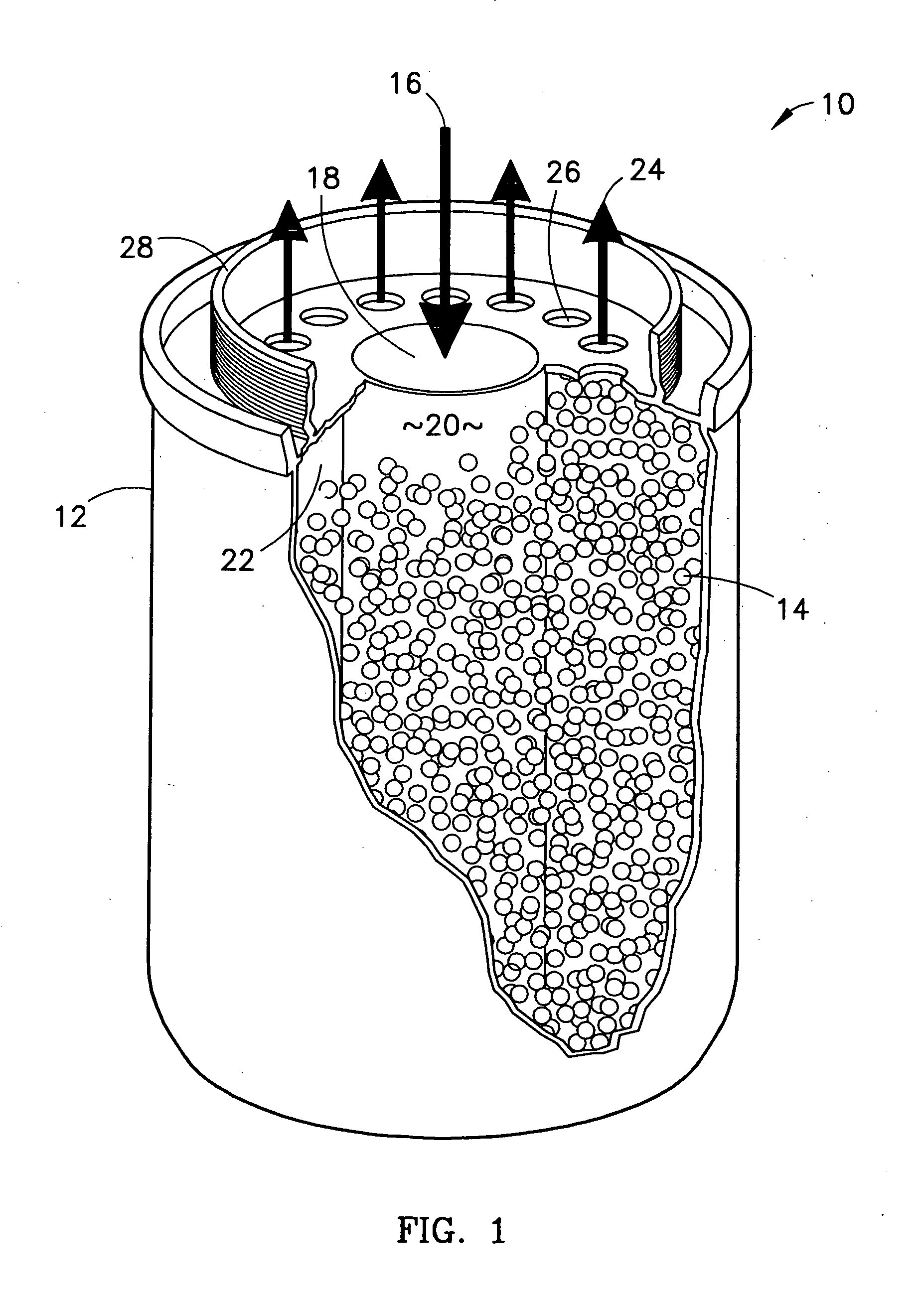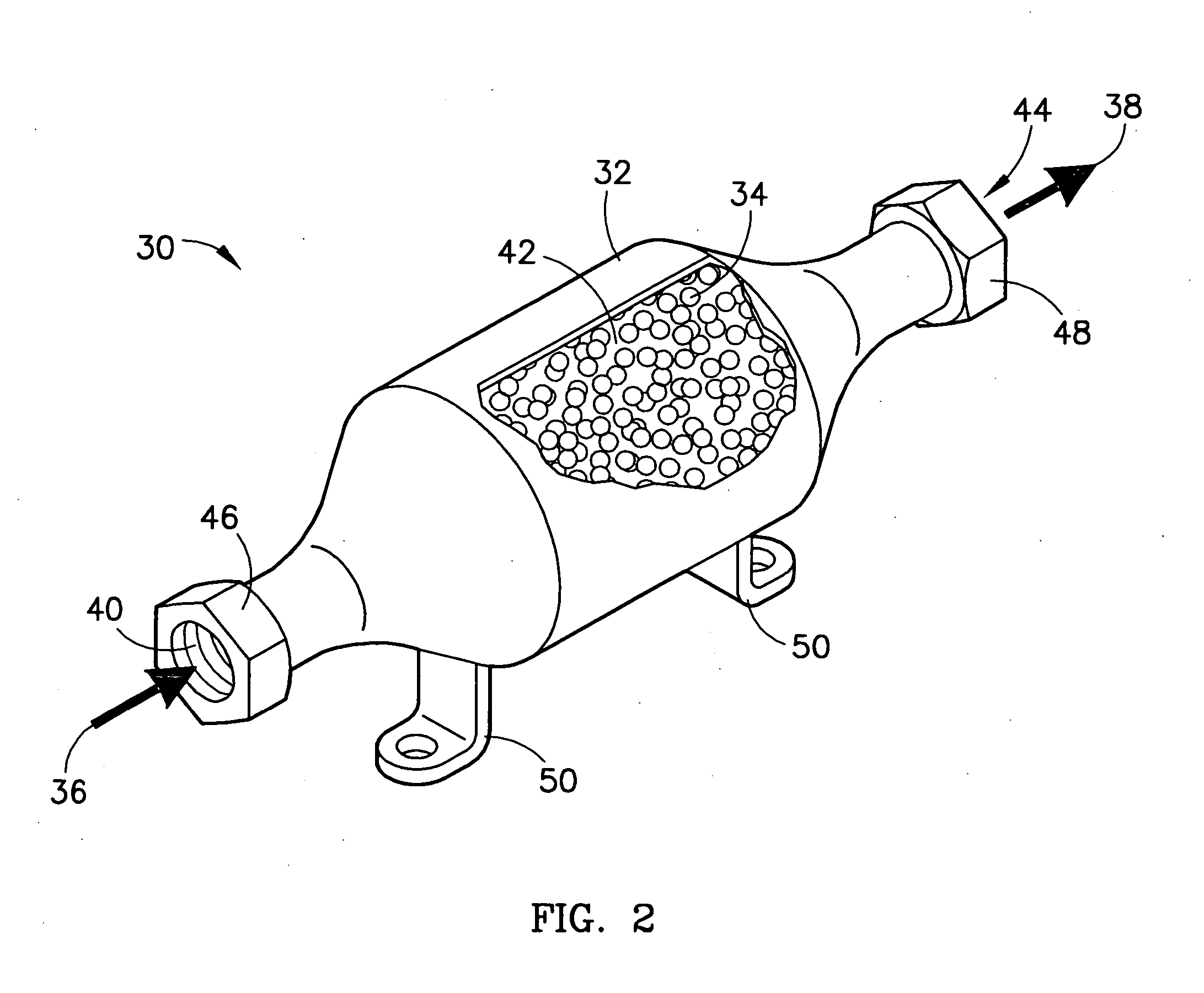Method of sorbing sulfur compounds using nanocrystalline mesoporous metal oxides
a mesoporous metal oxide and sulfur compound technology, applied in metal/metal-oxide/metal-hydroxide catalysts, physical/chemical process catalysts, other chemical processes, etc., can solve the problem of unacceptably high concentration of organosulfur compounds in the fuel stream, extremely sensitive metal catalysts to sulfur poisoning, etc. problem, to achieve the effect of reducing sulfur compound levels
- Summary
- Abstract
- Description
- Claims
- Application Information
AI Technical Summary
Benefits of technology
Problems solved by technology
Method used
Image
Examples
example 1
[0038] In this example, nanosized Al2O3 particles were impregnated with silver ions. In a 250 ml round bottom flask, about 0.2 g of nanosized Al2O3 (also referred to as AP—Al2O3) prepared by the aerogel method described by Utamapanya et al., Chem. Mater., 3:175-181 (1991), incorporated by reference herein, 0.11 g of silver acetylacetonate (Aldrich), and 25 ml of tetrahydrofuran (Fisher) were combined. The resulting slurry was stirred at room temperature for about 24 hours and protected from exposure to light with aluminum foil. After stirring, the mixture was centrifuged, washed with tetrahydrofuran approximately 4-5 times to remove excess silver acetylacetonate, and dried in a drying cabinet for about 2 hours. The brown powder that remained was heated at 500° C. under an air atmosphere inside a muffle furnace for about 3 hours. The final product was a brownish black powder and was designated Ag-AP—Al2O3.
example 2
[0039] This example describes the adsorption of thiophene using Ag-AP—Al2O3 prepared according to Example 1. To about 0.1 g of Ag-AP—Al2O3, 10 ml of thiophene solution in pentane (9.9×10−5 M) was added. The sorption of thiophene was allowed to proceed at room temperature for about 15 hours. The degree of thiophene sorption on Ag-AP—Al2O3 was determined by measuring the UV—V is spectrum of the supernatant solution. Analysis showed that the silver ion impregnated AP—Al2O3 was successful in scavenging thiophene from the pentane solution.
example 3
[0040] This example relates to impregnation of nanocrystalline MgO with nickel ions (Ni2+), the final product being designated Ni2+-AP—MgO. In a 250 ml round bottom flask, 0.2 g of nanosized MgO (also referred to as AP—MgO) prepared by the aerogel method, 0.1 g of nickel acetylacetonate, and 25 ml of tetrahydrofuran are combined. The slurry is stirred at room temperature for about 24 hours. The mixture is centrifuged, washed with tetrahydrofuran, and dried in a drying cabinet for about 2 hours. The resulting powder undergoes calcination for about 3 hours inside a muffle furnace at 500° C. initially under an air atmosphere switching over to a vacuum. Ni2+-AP—Al2O3 may be prepared in a similar manner by substituting AP—Al2O3 for MgO. Similarly, Cu+, Au+, Ga3+, and In3+ may be substituted for Ni2+ in this process and the metal oxide impregnated therewith.
PUM
| Property | Measurement | Unit |
|---|---|---|
| Fraction | aaaaa | aaaaa |
| Size | aaaaa | aaaaa |
| Nanoscale particle size | aaaaa | aaaaa |
Abstract
Description
Claims
Application Information
 Login to View More
Login to View More - R&D
- Intellectual Property
- Life Sciences
- Materials
- Tech Scout
- Unparalleled Data Quality
- Higher Quality Content
- 60% Fewer Hallucinations
Browse by: Latest US Patents, China's latest patents, Technical Efficacy Thesaurus, Application Domain, Technology Topic, Popular Technical Reports.
© 2025 PatSnap. All rights reserved.Legal|Privacy policy|Modern Slavery Act Transparency Statement|Sitemap|About US| Contact US: help@patsnap.com


